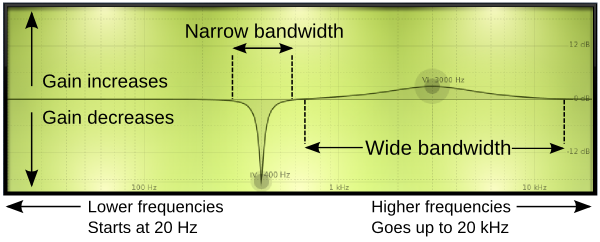Updated: Tue, 2014-08-19 07:22
A common setting on compressors. This is related to the attack setting. Where the attack setting tells the compressor when to kick in, the release tells the compressor when to stop compressing the signal. Release settings are measured in milliseconds.
Updated: Wed, 2014-08-13 14:57
A common setting on compressors and various types of filters. In compressors, this determines how quickly the compressor effect will kick in/how long it takes to pull the gain down. This is measured in milliseconds. Setting a few milliseconds of an attack allows the initial attack to come through and can sound punchier.
Updated: Tue, 2014-08-19 07:21
A common setting on compressors. This setting relates to a compressors threshold setting. The higher the ratio setting, the more compression will be applied to any audio that breaches the threshold. On lower settings, the compression affect will be more subtle. Ratio settings are also found on gates.
Updated: Wed, 2014-08-13 15:37
A common setting on compressors. This setting sets the threshold for what level the audio signal will kick in, eg if it's set to -15dBFS, this means that the threshold settings will affect any audio that breaches this threshold. On a gate, the threshold setting refers to the point below which the audio cuts off.
Updated: Tue, 2014-08-19 07:09
A DAW, which stand for Digital Audio Workstation, is software used for the recording, editing and mixing of digital audio. DAW's started off as integrated hardware units but nowadays, a DAW most commonly refers to recording software.
DAW's follow many conventions from hardware recording set ups. You even have a virtual mixer console and can route audio similarly to hardware set ups. You can also process individual audio tracks using plugins such as EQ, compressors and reverbs.
Updated: Wed, 2014-08-13 15:01
Chorus is a popular modulation effect, often used on guitars. This effect is most often described as adding a 'lush' or 'dreamy' effect that thickens up the sound source. This effect is achieved by splitting the sound source in two and delaying the copy. It's delay time is then modulated/varied alongside the original signal.
Updated: Mon, 2014-08-18 21:59
EQ, or equalizers, can manipulate the frequency response of audio material in various ways. There are 3 parameters that EQ's typically have, gain, frequency and Q. Gain relates to increasing or decreasing a specific frequency. Frequency relates to which frequency is being manipulated and Q, or bandwidth, relates to how many frequencies around the selected frequency are also affected.

Updated: Fri, 2014-11-14 13:54
Due to Linux audio's flexibility, very modular set ups are possible. Session management makes this easy by remembering software and their connections. You can launch various programs, connect them up and have you session manager remember, and later, relaunch the whole session, connections included. Some popular session management tools include Non Session Manager (NSM), Ladish and Jack session.
Updated: Tue, 2014-08-19 07:16
LinuxVST's are VST plugins compiled specifically for Linux. Supported hosts include Ardour, Qtractor and Carla.
Updated: Tue, 2014-08-19 10:35
The LV2 plugin standard is the successor to LADSPA. LV2, which stands for LADSPA version 2, is intended to address the limitations of LADSPA. LV2 plugins can easily be extended and most LV2 plugins come with custom GUI's. Supported hosts include Ardour, Qtractor and Carla. A popular collection of LV2 plugins is the Calf plugin suite.
Pages